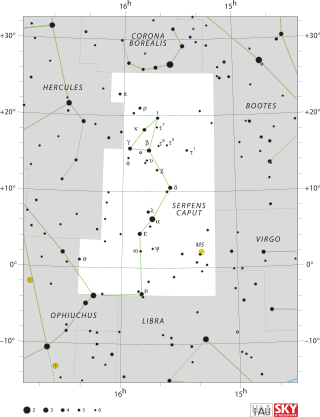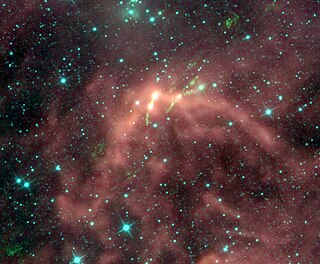
Serpens is a constellation in the northern celestial hemisphere. One of the 48 constellations listed by the 2nd-century astronomer Ptolemy, it remains one of the 88 modern constellations designated by the International Astronomical Union. It is unique among the modern constellations in being split into two non-contiguous parts, Serpens Caput to the west and Serpens Cauda to the east. Between these two halves lies the constellation of Ophiuchus, the "Serpent-Bearer". In figurative representations, the body of the serpent is represented as passing behind Ophiuchus between Mu Serpentis in Serpens Caput and Nu Serpentis in Serpens Cauda.

Star formation is the process by which dense regions within molecular clouds in interstellar space, sometimes referred to as "stellar nurseries" or "star-forming regions", collapse and form stars. As a branch of astronomy, star formation includes the study of the interstellar medium (ISM) and giant molecular clouds (GMC) as precursors to the star formation process, and the study of protostars and young stellar objects as its immediate products. It is closely related to planet formation, another branch of astronomy. Star formation theory, as well as accounting for the formation of a single star, must also account for the statistics of binary stars and the initial mass function. Most stars do not form in isolation but as part of a group of stars referred as star clusters or stellar associations.

Cepheus is a constellation in the far northern sky, named after Cepheus, a king of Aethiopia in Greek mythology. It is one of the 48 constellations listed by the second century astronomer Ptolemy, and it remains one of the 88 constellations in the modern times.

NGC 300 (also known as Caldwell 70) is a spiral galaxy in the constellation Sculptor. It is one of the closest galaxies to the Local Group, and probably lies between the latter and the Sculptor Group. It is the brightest of the five main spirals in the direction of the Sculptor Group. It is inclined at an angle of 42° when viewed from Earth and shares many characteristics of the Triangulum Galaxy. It is 94,000 light-years in diameter, somewhat smaller than the Milky Way, and has an estimated mass of (2.9 ± 0.2) × 1010M☉.

NGC 4323 is a lenticular or dwarf elliptical galaxy located about 52.5 million light-years away in the constellation Coma Berenices. The galaxy was discovered in 1882 by astronomer Wilhelm Tempel and is a member of the Virgo Cluster.

Westerhout 40 or W40 is a star-forming region in the Milky Way located in the constellation Serpens. In this region, interstellar gas forming a diffuse nebula surrounds a cluster of several hundred new-born stars. The distance to W40 is 436 ± 9 pc, making it one of the closest sites of formation of high-mass O-type and B-type stars. The ionizing radiation from the massive OB stars has created an H II region, which has an hour-glass morphology.

NGC 1407 is an elliptical galaxy in Eridanus. It is at a distance of 76 million light-years from Earth. It is the brightest galaxy in the NGC 1407 Group, part of the Eridanus Group, with NGC 1407 being its brightest member. NGC 1400, the second-brightest of the group lies 11.8 arcmin away.

NGC 4242 is a spiral galaxy in the northern constellation of Canes Venatici. The galaxy is about 18 million light years away. It was discovered on 10 April 1788 by William Herschel, and it was described as "very faint, considerably large, irregular, round, very gradually brighter in the middle, resolvable" by John Louis Emil Dreyer, the compiler of the New General Catalogue.

NGC 3311 is a supergiant elliptical galaxy located about 190 million light-years away in the constellation Hydra. The galaxy was discovered by astronomer John Herschel on March 30, 1835. NGC 3311 is the brightest member of the Hydra Cluster and forms a pair with NGC 3309 which along with NGC 3311, dominate the central region of the Hydra Cluster.

NGC 1266 is a lenticular galaxy in the constellation Eridanus. Although not currently starbursting, it has undergone a period of intense star formation in the recent past, ceasing only ≈500 Myr ago. The galaxy is host to an obscured active galactic nucleus.

NGC 708 is an elliptical galaxy located 240 million light-years away in the constellation Andromeda and was discovered by astronomer William Herschel on September 21, 1786. It is classified as a cD galaxy and is the brightest member of Abell 262. NGC 708 is a weak FR I radio galaxy and is also classified as a type 2 Seyfert galaxy.

NGC 4636 is an elliptical galaxy located in the constellation Virgo. It is a member of the NGC 4753 Group of galaxies, which is a member of the Virgo II Groups, a series of galaxies and galaxy clusters strung out from the southern edge of the Virgo Supercluster. It is located at a distance of circa 55 million light years from Earth, which, given its apparent dimensions, means that NGC 4636 is about 105,000 light years across.

NGC 1386 is a spiral galaxy located in the constellation Eridanus. It is located at a distance of circa 53 million light years from Earth, which, given its apparent dimensions, means that NGC 1386 is about 50,000 light years across. It is a Seyfert galaxy, the only one in Fornax Cluster.

NGC 4294 is a barred spiral galaxy with flocculent spiral arms located about 55 million light-years away in the constellation Virgo. The galaxy was discovered by astronomer William Herschel on March 15, 1784 and is a member of the Virgo Cluster.

NGC 4299 is a featureless spiral galaxy located about 55 million light-years away in the constellation Virgo. It was discovered by astronomer William Herschel on March 15, 1784 and is a member of the Virgo Cluster.

NGC 4302 is an edge-on spiral galaxy located about 55 million light-years away in the constellation Coma Berenices. It was discovered by astronomer William Herschel on April 8, 1784 and is a member of the Virgo Cluster.

NGC 4318 is a small lenticular galaxy located about 72 million light-years away in the constellation Virgo. It was discovered by astronomer John Herschel on January 18, 1828. NGC 4318 is a member of the Virgo W′ group, a group of galaxies in the background of the Virgo Cluster that is centered on the giant elliptical galaxy NGC 4365.

The dark nebula Barnard 203 or Lynds 1448 is located about one degree southwest of NGC 1333 in the Perseus molecular cloud, at a distance of about 800 light-years. Three infrared sources were observed in this region by IRAS, called IRS 1, IRS 2 and IRS 3.



















